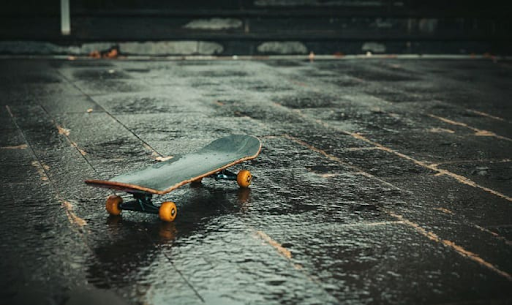Skating Locator
Is it Bad to Skateboard on Wet Ground?

I was recently wondering if it’s okay to skateboard when the ground is wet or if it could damage the board. I did a little research to find out the answer.
So, is it bad to skateboard on wet ground? When the wood and bearings of your skateboard are wet, it causes great damage. The wood will warp and the bearings will rust. In addition to being bad for the board, the road conditions also make things dangerous for the skateboarder. Skating boarding on wet pavement should be avoided when possible.
There is a lot to know about skateboarding on wet ground and what to do if you have no other choice. Before skateboarding on wet pavement, learn what could happen and how to fix your board if needed.
The Dangers of Skateboarding on Wet Pavement
Skateboarding on wet pavement is not only bad for the board itself but also for the skateboarder. Here are some of the dangers:
Warped Skateboard Deck. Skating boarding when the ground is wet or when it’s raining is harmful to the deck of the board because it will soak up water and warp the wood. You should never leave a wet skateboard just to sit and drip. Always dry it off immediately and even consider using a hair dryer to dry it off. It’s even recommended to carry around a towel with you so that you can dry off your board immediately.
Rusted Bearings and Trucks. Wet bearings and trucks will certainly rust and breakdown when they are wet, becoming a danger to the rider. All it takes is a little moisture on the ground to splash up on the wheels to cause damage to your bearings and trucks. Skateboard bearings range in price greatly. Depending on how inexpensive they are, you may just want to replace them if they get wet. If they are expensive, you’ll want to take them off the board, dry them with a paper towel and hair drier, apply a lubricant, and put them back on.
Dangers to the Skateboarder. Water reduces your wheel’s grip on the pavement, making it very dangerous to skateboard in wet skate parks and on other surfaces. If the skateboard wheels leave tracks on the ground after skating, the ground is too wet and should not be skated on. You can easily lose control of your skateboard and hydroplane, potentially resulting in serious injury.
For all these reasons, it’s never a good idea to skateboard on wet pavement, unless you don’t care about damaging your board and the ground is not too slippery. Some people have found it to be a new challenge to see if they can successfully skateboard in the rain and perform spectacular tricks.

How to Tell if Your Skateboard is Waterlogged?
There’s nothing worse than meticulously being sure not to skateboard into puddles and then… you miss a trick and your board lands right in a huge puddle. If you find that your board is waterlogged, your deck is ruined and the whole thing will need replaced.
There are a few different ways to tell if your skateboard is water logged.
The sound. If your skateboard is waterlogged, it won’t make the sounds you expect it to. Everything will sound muffled. One of the best tests you can do is to stand on the nose or tail of the skateboard and let the board fall on a hard surface. If the skateboard is not waterlogged, it will have a nice sound like when landing a trick. Waterlogged skateboards have less bounce and a weird sound. You might also found that your board sounds like a creaking floorboard.
The weight. Boards that are waterlogged are much much heavier than a non-waterlogged board. They are on average, three times heavier to be exact. This causes a muffled “thud” when you land a trick that doesn’t sound like an undamaged board.
Evidence of warping. If you hold your skateboard vertically with the tail on the ground and see the board twisting like a corkscrew, your board is warped. A warped board will bend and change shape over time. Warping is not only caused by getting the board wet but also by being exposed to prolonged humidity.
The condition of the board. When the board is waterlogged and beginning to warp, you’ll often see chipping and splitting on the board. The glue that holds the board layers together loses it’s tackiness, causing chipping and splitting on the board.
How Do You Dry a Wet Skateboard?
If your board was left out in the rain for hours on end, your board is likely ruined and you’ll need a new one. There isn’t much you’ll be able to do to save it. You can try drying it out in the sun, but your chances of saving it are slim.
If your skateboard gets wet just a little bit caught in the rain for 10 minutes or so, here is what you should do:
- Remove all the hardware and disconnect the trucks from the board deck. Use a towel to dry to board, grip tape, hardware, and trucks as best as you possibly can.
- Next, remove the wheels from your skateboard and dry out the inside and outside of the bearings with a Q-tip. Spray WD-40 or skateboard lube on the wheels as you rotate them to lubricate the bearings. You should do this within a day to prevent the bearings from rusting.
- Allow your skateboard deck to sit in the sun with the grip tape face up for as long as possible. If rainy weather prevents you from letting it sun dry, put it in your garage and let it air dry for as long as you can.
- To see if your board is dried, drop it on the ground and listen to the sound it makes. If it feels heavy and makes a muffled thumping sound, your board is waterlogged and it completely ruined and needs to be replaced.
- If the board sounds like it should, re-assemble all the parts.

Most wet skateboard bearings do not recover. However, you may be able to save them if you act fast and take care of them right away. Here is what you should do to fix wet skateboard bearings:
- Use a wrench to remove the axle nut at the center of the wheel and remove the wheel.
- Pry the wheel in a downward angle to remove it.
- You should have two bearings (one on the top and one on the bottom) and one bearings spacer.
- Soak them in a safe cleaner that will dissolve oil, grease, and remove dirt from the steel, plastic and rubber surfaces. You can put the cleaner and the bearings in a bottle and shake the bottle. Dump out the cleaner and refill the bottle, repeating the process until the cleaner pours out clear.
- Dry all the parts with a paper towel and dry with a hair dryer to ensure that you’ve removed all moisture to prevent rusting.
- Replace your bearings and put the wheels back on exactly as you removed them and you should be good to go.
Related Questions
How tight should skateboard trucks be? The tightness of your trucks will determine how well you can do some tricks. The trucks should only be finger tight to give you optimal control. If you are looking for more speed you should tighten the trucks more.
How much water does it take to waterlog a skateboard? Riding your skateboard in the rain for a little while usually isn’t enough to waterlog your board. It’ll do damage to the bearings and trucks though. If your board is submerged in water, even if just for five minutes, your board will likely be waterlogged and ruined.
Why does my skateboard turn to the left? If you’re bushings aren’t even due to habitually leaning more to one side than the other, it could cause you’re board to turn left on it’s own. Simply lean more to the other side (even if you’re not skating) to help even out the bushings. You could also try straightening or tightening the kingpin.
